
You know the sinking feeling when a valued employee hands in their resignation. It disrupts your team, strains your budget, and pushes you into a reactive scramble to hire and train replacements. Yet, despite these clear costs, many organizations still treat turnover as an unavoidable part of doing business.
Gallup research reveals that 42% of employee turnover could be avoided, yet many organizations overlook the warning signs and miss key opportunities to intervene. Understanding how to calculate your employee turnover rate is the first step in developing strategies to retain your top talent.
In this guide, we break down the formula, walk you through a step-by-step calculation, and share tips to help you effectively interpret and act on the results.
Employee turnover rate is a simple metric that shows how frequently employees leave your company over a specific period. It helps you track workforce changes and spot trends in employee movement.
Employee turnover rate:
Before addressing turnover, it is essential to understand why consistently measuring it matters for your organization. This is explained in the next section.
Tracking employee turnover is more than a numbers exercise. It helps you uncover patterns, control costs, and strengthen your workforce. When you measure turnover regularly, you gain insights to improve retention and plan strategically.
To get started, you need to know how to calculate your employee turnover rate accurately. The formula for calculating employee turnover rate is explained in the next section.
Once you understand why turnover matters, the next step is learning how to calculate it. The formula is straightforward and provides a clear percentage to track over time.

These are a few key components:
Alternative Approach
Some organizations prefer a simpler method by dividing the number of terminations by the number of employees at the beginning of the period.
This approach offers a stable point of reference, especially useful for comparing turnover across periods. However, it does not account for workforce fluctuations throughout the period.

When to use this formula:
These formulas can be applied on a monthly or annual basis, depending on the analysis period and business needs. For monthly turnover, organizations track separations and employee counts within a single month to monitor short-term trends.
Annual turnover calculations offer a broader view of employee retention and workforce stability over the entire year, as shown in the example in the next section.
The following section outlines the simplest method for calculating the employee turnover rate on both an annual and monthly basis.
Suggested Read: Top 5 Pave Alternatives and Competitors in 2025
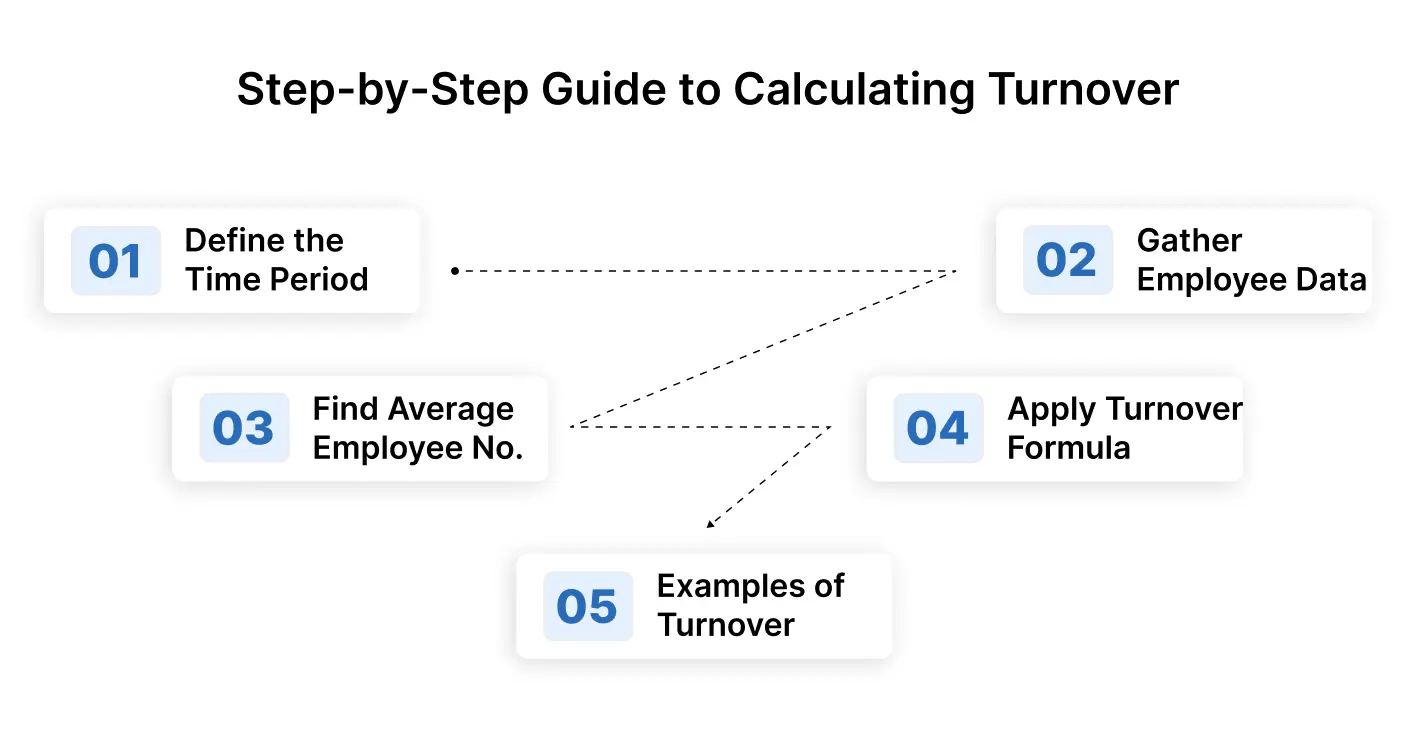
Calculating turnover accurately requires more than just plugging numbers into a formula. Here is a detailed process to help you do it right, whether you are tracking monthly or annual turnover.
Start by deciding the time frame you want to measure.
Collect accurate HR data for the chosen period:
Tip: Exclude internal transfers or promotions. Only count people leaving the organization entirely.
To calculate the average workforce size:
This step adjusts for fluctuations in staff numbers during the period, giving a fair baseline for turnover calculation.
Use the formula:

This will give you the turnover rate as a percentage, making it easy to compare across months or years.
To make this process concrete, let us walk through two practical examples. There are two different examples here for monthly turnover and for annual turnover.
These examples show how small differences in employee movement can impact your overall rate and highlight trends worth monitoring.
Imagine your organization had these numbers for March.
Calculation:

Insight: A 6.8% turnover rate in a single month may not seem alarming, but if this pattern repeats over several months, it could indicate a retention issue requiring immediate action.
Now consider your organization’s data for the full year:
Calculation:
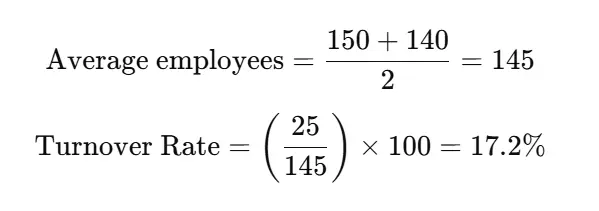
Insight: An annual turnover rate of 17.2% might be acceptable in some industries. But, if it is significantly above your sector’s benchmark, it is worth investigating causes such as pay competitiveness, career growth opportunities, or management practices.
Regularly calculating turnover helps you spot patterns before they escalate. But as simple as this process seems, there are common challenges that can trip you up and lead to inaccurate numbers.
Suggested Read: Creating a Compensation Job Offer Letter: A Template Guide for Every Situation
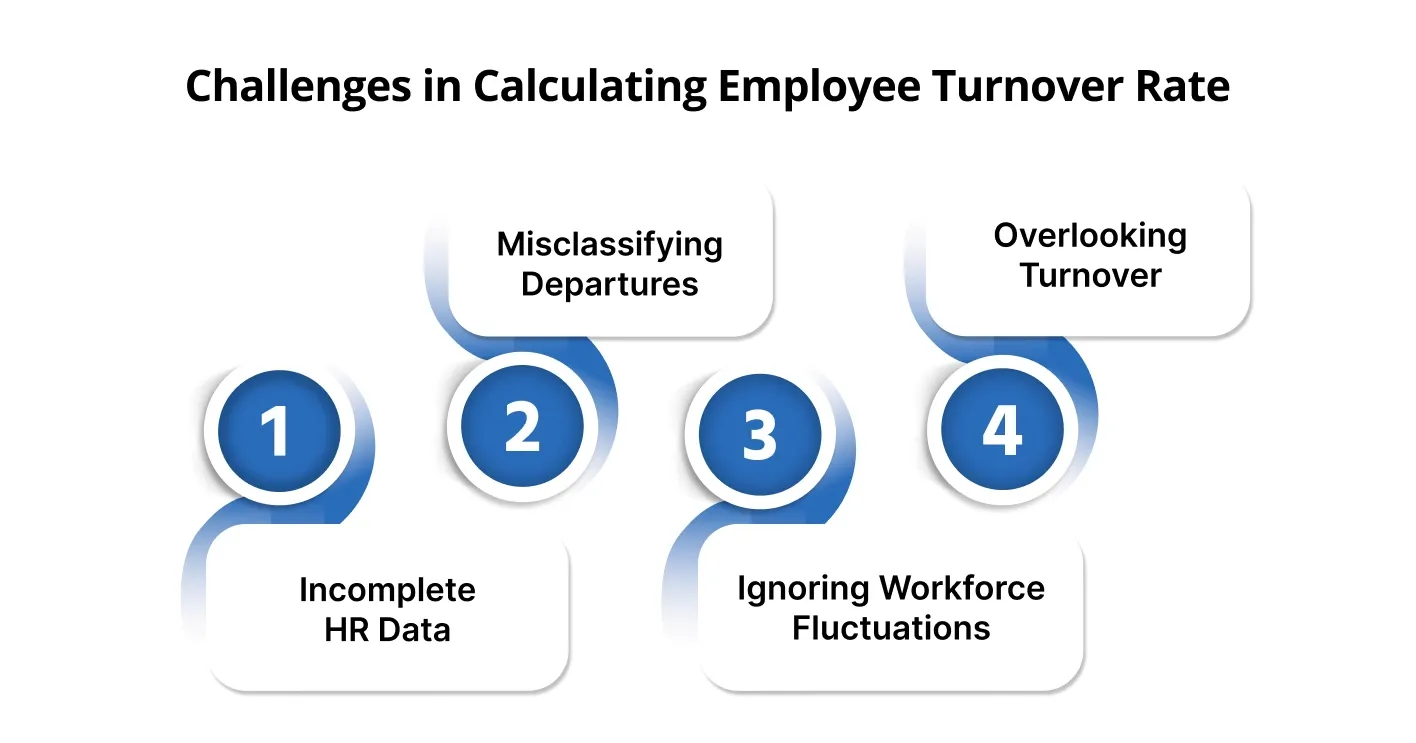
While the formula for turnover is straightforward, real-world situations often create hurdles that can skew your results. Being aware of these challenges helps you avoid mistakes and calculate a more accurate rate.
Messy or outdated HR records can lead to incorrect headcounts and separation numbers, resulting in inaccurate turnover rates. This is especially common in organizations without centralized HR systems.
Solution: Implement regular data audits and use reliable HR software to maintain clean, up-to-date employee records. Ensure clear processes for tracking hires, separations, and internal moves.
Including employees who transfer internally or are on long-term leave can inflate turnover figures. Similarly, failing to account for temporary or seasonal workers can distort your calculations.
Solution: Clearly define what counts as a separation (e.g., permanent exits only) and apply it consistently. Exclude internal transfers and ensure temporary staff are counted only when relevant.
Organizations with large seasonal hiring spikes or downsizing events may see turnover rates that do not reflect long-term trends. Using only start or end headcounts amplifies this issue.
Solution: Always calculate the average headcount for the period to smooth out fluctuations. For seasonal businesses, compare turnover rates year-over-year for more meaningful insights.
Combining voluntary resignations with involuntary separations (layoffs, terminations) can mask underlying retention problems.
Solution: Track and report voluntary and involuntary turnover separately. This distinction helps you identify avoidable exits versus structural workforce changes.
By tackling these challenges, you can improve the accuracy of your turnover calculations and build a stronger foundation for workforce planning.
Next, let us look at practical tips to ensure your turnover tracking stays on point.
Suggested Read: Steps to Create a Fair and Equitable Compensation System
Getting your turnover calculations right is essential for meaningful insights. Small errors or overlooked details can lead to skewed results and poor decision-making.
Use these tips to keep your calculations precise and actionable.
Accurate turnover rates are a powerful HR metric, but there is no single way to calculate them. Depending on your goals, you might consider alternative approaches that provide different insights.
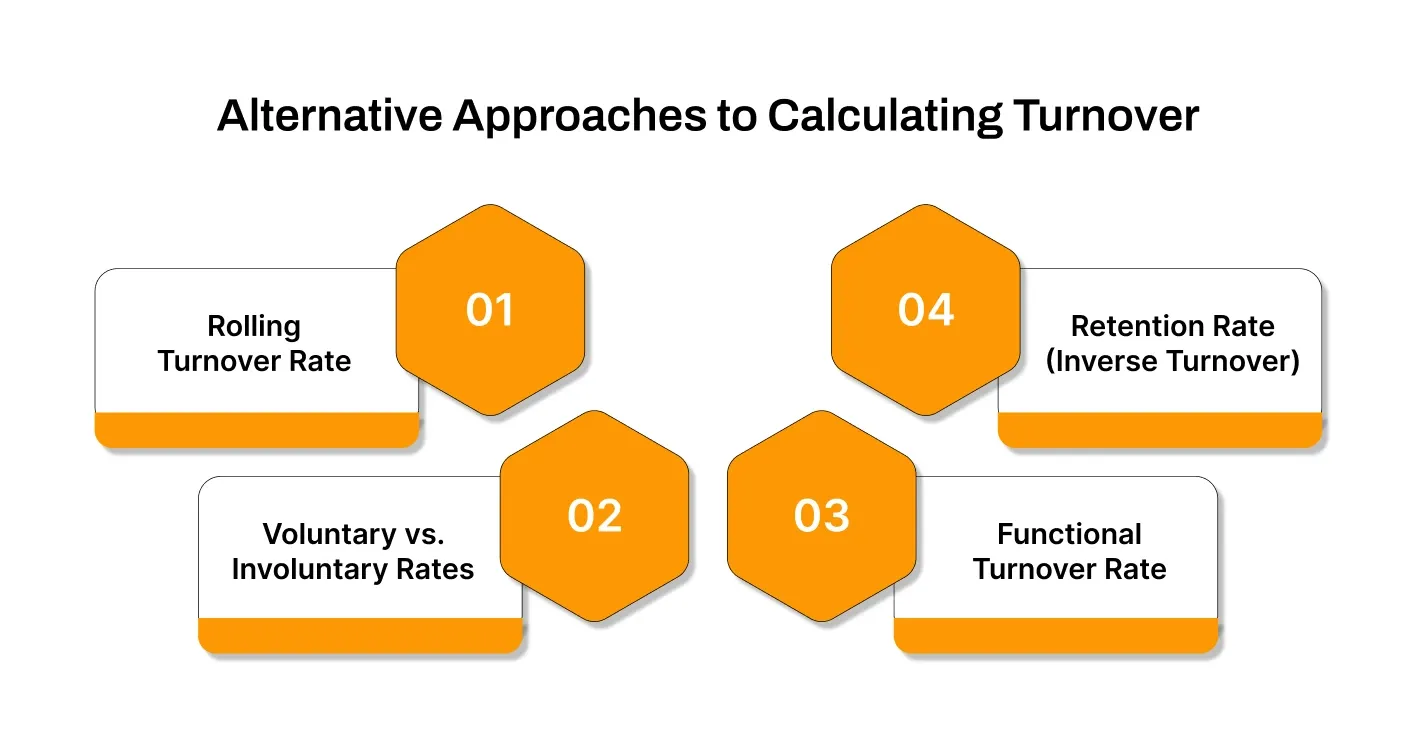
The standard turnover formula works well for most organizations, but alternative methods can provide deeper insights or fit unique workforce situations. Here are a few commonly used approaches and how they differ.
This method calculates turnover over the past 12 months on a rolling basis rather than a fixed calendar year. It helps organizations monitor trends continuously without waiting for annual data.
Best for: Businesses wanting up-to-date insights into retention patterns throughout the year.
Instead of combining all separations, this approach calculates separate rates for voluntary (resignations) and involuntary (terminations, layoffs) departures. It highlights avoidable exits versus organizational restructuring.
Best for: Identifying retention issues versus structural workforce changes.
Focuses on employees who left but were considered low performers or not critical to business success. This perspective helps organizations assess whether turnover was beneficial or harmful.
Best for: Organizations with performance-based retention goals.
Rather than focusing on departures, this measures the percentage of employees who stayed during a period. It offers a positive framing of workforce stability.
Best for: Presenting retention success to stakeholders or leadership.
While measuring turnover is crucial, the real value comes from acting on these insights. Next, let us explore practical strategies to reduce employee turnover and build a stronger, more engaged workforce.
Suggested Podcast: In our latest podcast, DEI expert Dr. Laura Quiros highlights how diversity, inclusion, and equity can directly improve retention. Her insight reminds us that belonging is a valuable strategy to reduce employee turnover.
Once you know your turnover numbers, the next step is to take action to retain your best talent. Reducing employee turnover requires a proactive, people-focused approach that addresses the reasons employees leave in the first place.
Reducing turnover is about implementing people-first policies and practices. But to truly maximize retention, you also need to use your turnover data strategically to guide better HR decisions.
Calculating turnover is only the first step. The real power lies in analyzing the data to uncover trends and shape smarter HR strategies. When used effectively, turnover insights can help you build a stronger, more resilient workforce.
Using turnover data in these ways requires solid analytics tools and real-time insights. This is where platforms like CompUp can help HR teams transform raw data into actionable strategies.
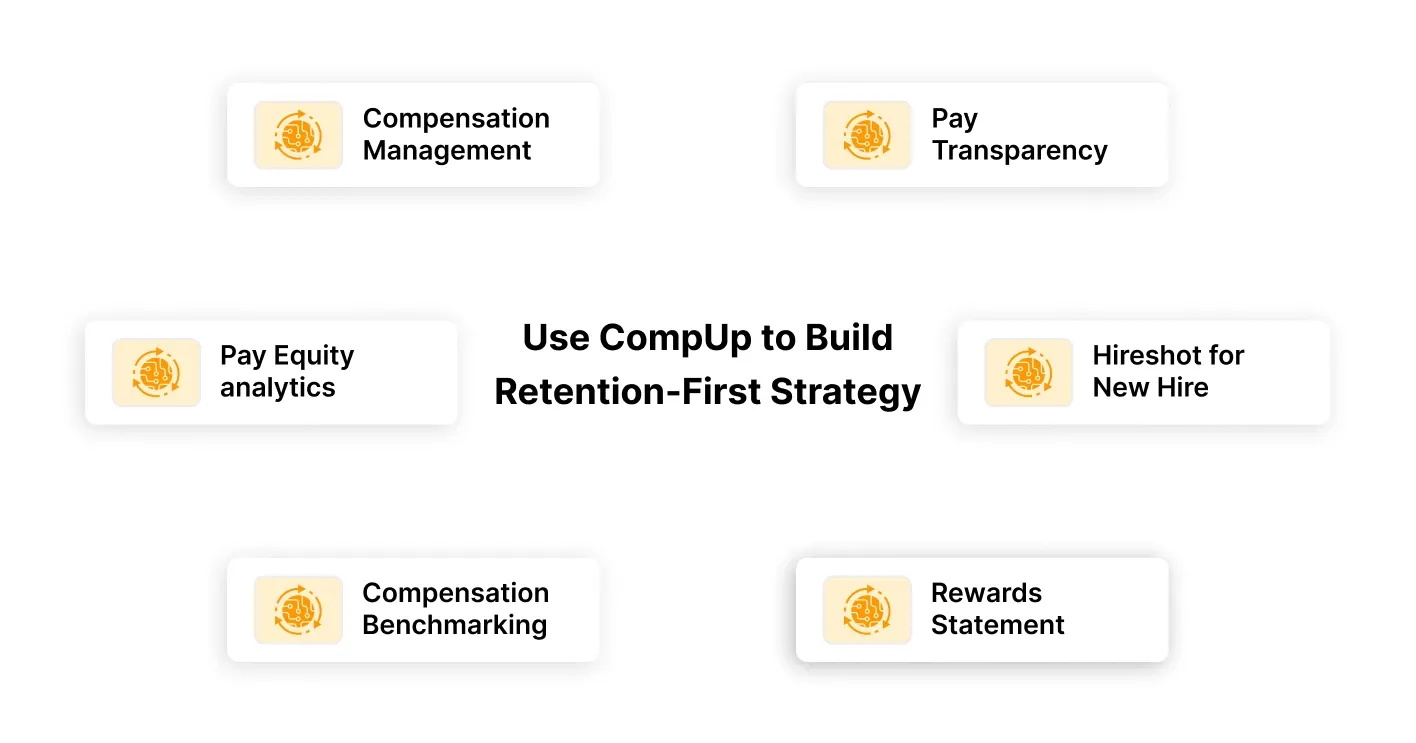
Reducing employee turnover requires more than reactive measures. It calls for a proactive strategy grounded in fair compensation, data-driven insights, and engaging employee experiences.
CompUp provides an end-to-end platform to help HR teams analyze turnover trends, address root causes, and create a workplace where employees want to stay.
Inconsistent or outdated pay structures often drive employees to leave for better offers. CompUp’s Compensation Management tools make it easier to maintain equitable and competitive pay. Compensation bands and budget simulations can help you design fair pay structures to make informed decisions during merit cycles.
A lack of clarity about how salaries and raises are determined can erode trust and drive attrition. CompUp simplifies pay transparency with clear internal compensation bands and policies, helping employees understand their growth potential and feel confident in staying long term.
Pay inequities can lead to higher turnover among underrepresented groups. CompUp identifies and helps correct pay gaps across roles, demographics, and locations, ensuring employees are compensated fairly and reducing voluntary exits linked to perceived unfairness.
Turnover often spikes in the first year due to unmet expectations. CompUp’s Hireshot enhances the new hire experience with professional digital offers, intelligent engagement touchpoints, and gamified onboarding. This approach keeps candidates connected and excited from offer acceptance to day one, lowering early attrition rates.
If your pay falls behind market standards, competitors can easily lure away your talent. CompUp provides real-time market data to help you stay competitive with compensation packages and retain your top performers.
Employees who cannot see the full value of their compensation are more likely to leave. CompUp’s Rewards Statement gives employees a clear, personalized view of their total compensation, including fixed, variable, equity, and benefits.
By integrating these features, CompUp transforms turnover data into actionable insights and equips organizations with the tools they need to retain their best talent. CompUp enables HR leaders to build workplaces that prioritize retention at every stage of the employee journey.
Tracking and understanding your employee turnover rate is essential for building a stable, high-performing workforce. You can reduce unwanted attrition and create a healthier workplace culture by measuring it accurately, identifying patterns, and implementing targeted retention strategies.
CompUp helps organizations take this a step further with tools for Compensation Management, Pay Equity, Pay Transparency, Rewards Statements, and Market Benchmarking. Together, these features allow HR teams to address turnover proactively and build a retention-first strategy that keeps top talent engaged and committed.
Start transforming your turnover insights into action. Contact us to understand how CompUp can help you build a stronger, more loyal workforce today.
1. How to interpret the employee turnover rate?
Employee turnover rate shows the percentage of employees leaving during a set period. Higher rates may indicate retention issues, while lower rates suggest stability. Compare against industry benchmarks to assess if your rate reflects a healthy workforce.
2. What is a healthy employee turnover rate?
A healthy turnover rate varies by industry, but generally falls between 10%–15% annually. Higher rates could signal workplace issues, while extremely low turnover might suggest limited growth opportunities or stagnation. Context and industry benchmarks are crucial.
3. What are employee turnover costs?
Turnover costs include recruiting, hiring, and training expenses, plus lost productivity and knowledge gaps. Indirect costs like lower morale and client dissatisfaction also add up, making employee turnover significantly more expensive than retaining existing talent.
4. What is the best way to calculate employee turnover?
Use the standard formula: number of employees who left during a period divided by the average headcount, multiplied by 100. For accuracy, ensure clean HR data and consider segmenting by role, location, or department.
5. What does a 20% turnover rate mean?
A 20% turnover rate means 20 out of every 100 employees left during the measured period. This can indicate potential retention challenges, especially if higher than industry norms, and should prompt analysis of underlying causes.

Community Manager (Marketing)
As a Community Manager, I’m passionate about fostering collaboration and knowledge sharing among professionals in compensation management and total rewards. I develop engaging content that simplifies complex topics, empowering others to excel and aim to drive collective growth through insight and connection.
Revolutionizing Pay Strategies: Don't Miss Our Latest Blogs on Compensation Benchmarking